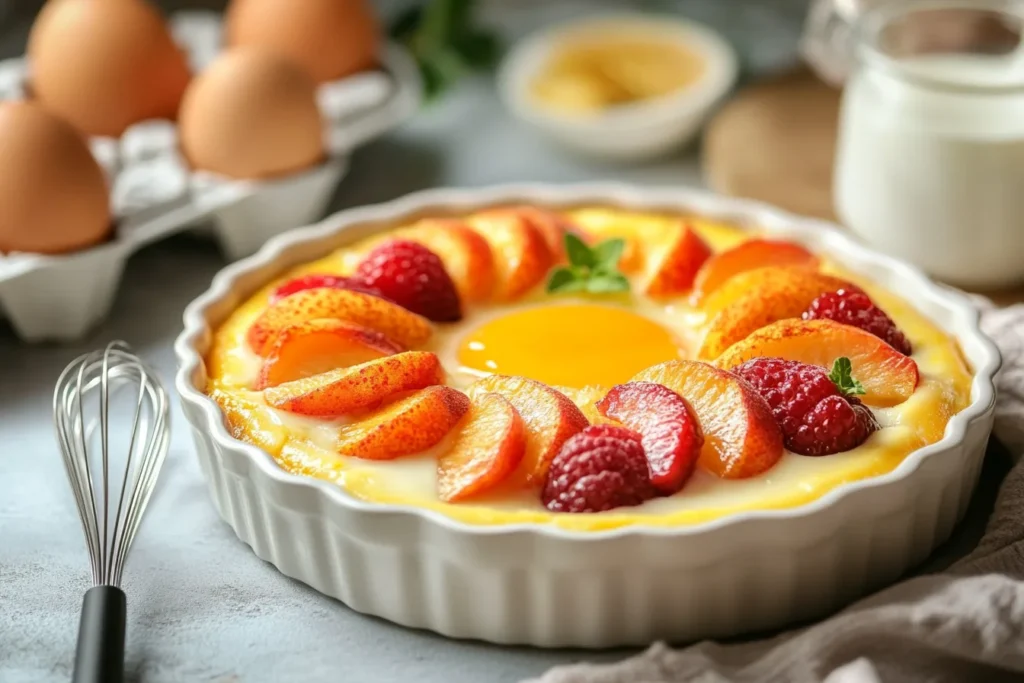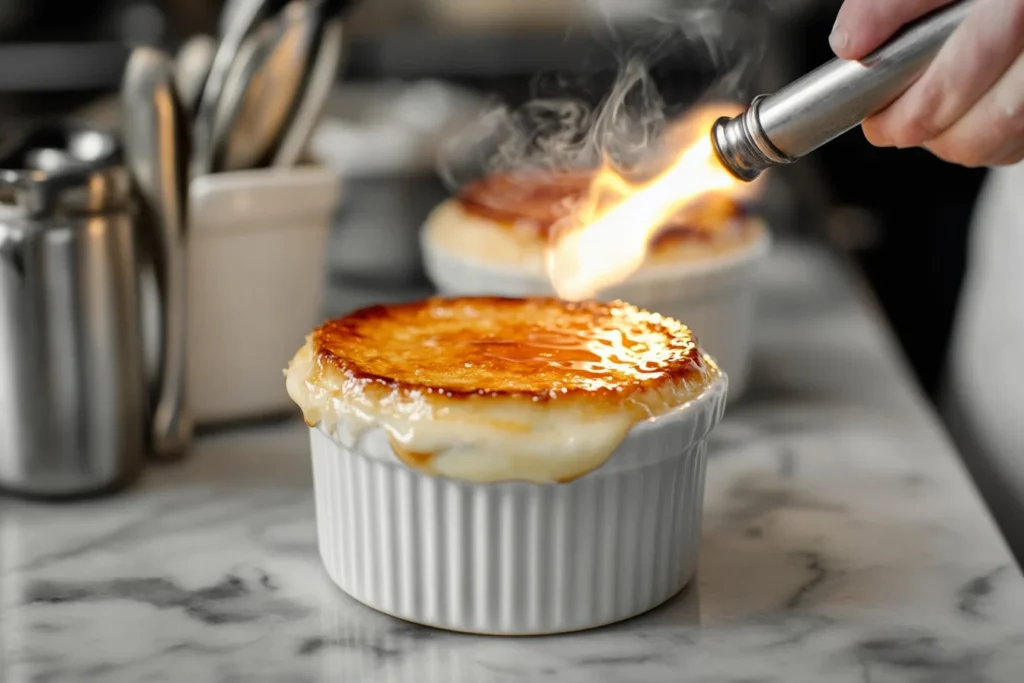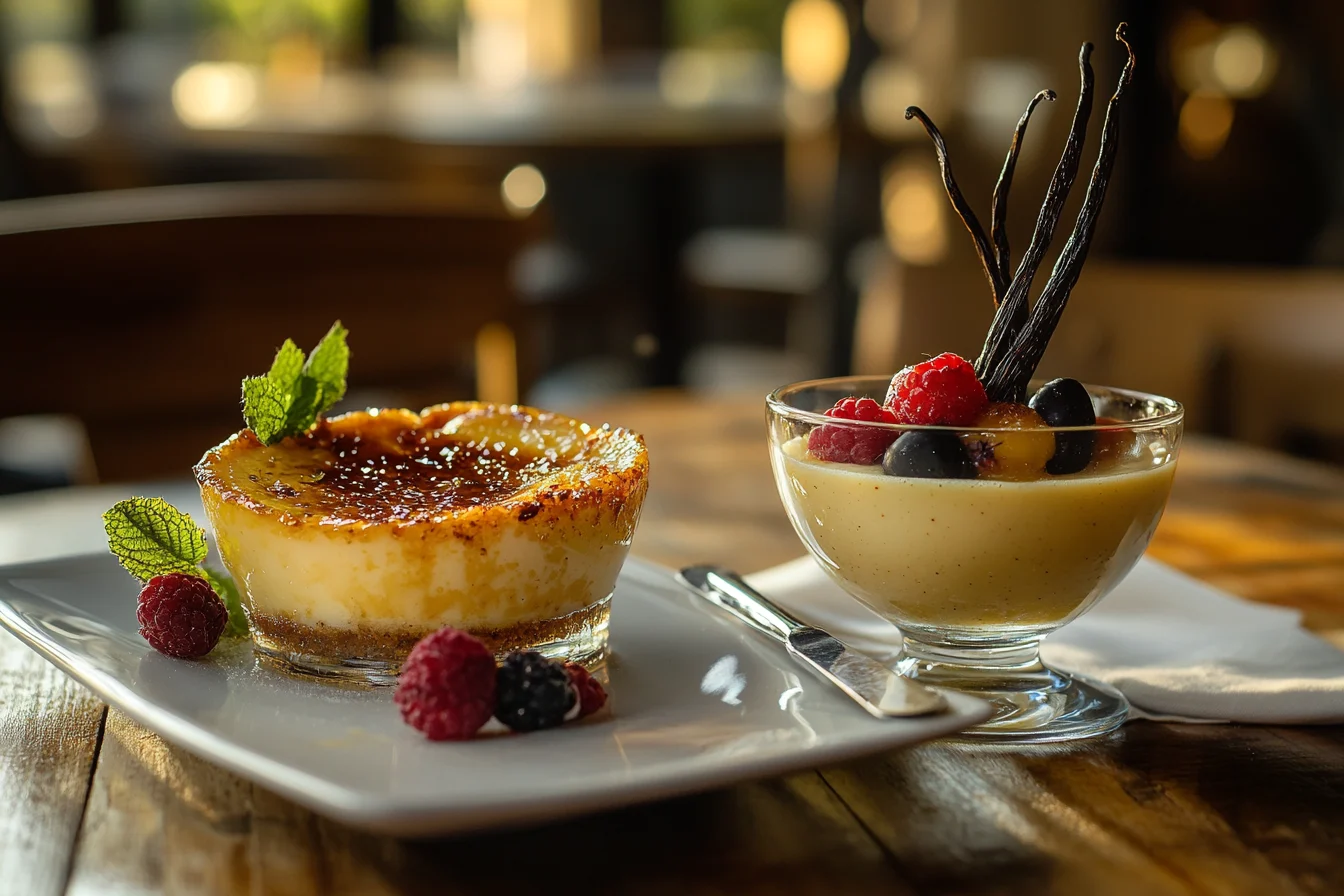Desserts are often the highlight of any meal, and for good reason—they satisfy cravings and leave a lasting impression. Among the most beloved desserts are crème brûlée and custard. At first glance, they might seem nearly identical. Both are creamy, egg-based delights that have carved out a niche in the culinary world. But dig a little deeper, and you’ll discover a world of fascinating differences in their ingredients, preparation, texture, and history. In this article, we’ll explore what sets crème brûlée apart from custard, offering insights into their unique qualities, preparation techniques, and even when to choose one over the other. Let’s dive in!
Introduction to Crème Brûlée and Custard
What Are Crème Brûlée and Custard?
Crème brûlée and custard both fall under the broad category of creamy desserts, but their identities are distinct. Crème brûlée, meaning “burnt cream” in French, is renowned for its rich custard base topped with a crispy, caramelized sugar layer. This dessert is often associated with elegance and sophistication, making appearances in fine-dining restaurants worldwide.
Custard, on the other hand, is more versatile. It serves as a base for countless desserts like pies, tarts, and trifles. Whether baked, stirred, or steamed, custard is a timeless favorite in homes and bakeries alike. It balances silky smoothness with subtle sweetness, making it a comforting and adaptable treat.
The Culinary Appeal of Each
Crème brûlée is all about indulgence. The contrast between the crunchy caramelized sugar crust and the velvety custard beneath creates a luxurious sensory experience. It’s the showstopper of desserts, often prepared tableside for added drama.
Custard, by contrast, is celebrated for its simplicity and versatility. It can be enjoyed on its own or as a component of more elaborate dishes. From vanilla-scented custards to bold chocolate versions, this dessert accommodates a variety of flavors and preferences.
Stay tuned as we move deeper into the fascinating world of crème brûlée and custard, exploring their ingredients, cooking techniques, and more!
Ingredients Comparison
Core Ingredients of Crème Brûlée
Crème brûlée is a dessert where simplicity meets sophistication. Its base is made from egg yolks, heavy cream, sugar, and a touch of vanilla. What makes it stand out is the perfect balance of richness and sweetness. The heavy cream provides the luscious texture, while the caramelized sugar topping adds a hint of bittersweet crunch.
The key to achieving the perfect crème brûlée lies in using high-quality ingredients. Fresh vanilla beans or pure vanilla extract give the custard its characteristic flavor. Also, the sugar topping must be evenly caramelized using a blowtorch to create the iconic brittle crust.
What Makes Custard Unique?

Custard, like crème brûlée, relies on eggs, milk or cream, and sugar as its core ingredients. However, its versatility shines through in the variety of forms it can take. While custard often includes vanilla, it can also be flavored with chocolate, citrus, or even spices like nutmeg.
The proportion of milk to cream varies depending on the type of custard being made. For example, a baked custard uses more eggs for structure, while stirred custards like crème anglaise are lighter and silkier. This flexibility is what makes custard a staple in both sweet and savory dishes.
If you’re curious about pairing custard with other desserts, check out this article on how creamy bases elevate recipes.
Cooking Techniques and Preparation
How Crème Brûlée is Made

The preparation of crème brûlée is as much an art as it is a science. The custard is gently baked in a water bath to ensure even cooking and a creamy texture. The water bath prevents the edges from curdling while the center sets perfectly. After cooling, a thin layer of sugar is sprinkled on top and caramelized with a blowtorch to form the signature crust.
Timing and temperature are crucial when making crème brûlée. Overbaking can lead to a rubbery texture, while underbaking results in a runny custard. The end goal? A custard so smooth it melts in your mouth, with a caramel topping that shatters with a satisfying crack.
Custard’s Cooking Methods
Custard offers a variety of preparation methods depending on the desired consistency. Baked custards, like flan or quiche, require gentle oven heat to firm up. Meanwhile, stirred custards, like crème anglaise, are cooked over low heat on a stovetop, constantly stirred to prevent curdling.
For both types, low and slow is the mantra. Patience is key to achieving the silky, rich texture custard is known for. And don’t forget—using a fine-mesh strainer before baking or serving helps remove any lumps, ensuring a velvety result every time.
This comparison helps illuminate what’s the difference between crème brûlée and custard in terms of both preparation and final texture. Each technique highlights the unique characteristics of these desserts while showcasing their shared foundation in culinary art.
Texture and Flavor Profiles
Crème Brûlée: Rich and Decadent
One of the most striking aspects of crème brûlée is its indulgent texture. Its silky smooth custard is contrasted by the crisp layer of caramelized sugar on top. When you crack the hardened sugar crust with a spoon, it reveals a creamy, velvety interior that feels luxurious on the palate.
The flavor of crème brûlée leans toward the rich and sweet, often enhanced by the use of vanilla beans. The caramelized sugar topping adds a slight bitterness, balancing the sweetness and giving it a sophisticated flavor profile. This combination makes crème brûlée an ideal dessert for special occasions or elegant dinners.
Custard: Smooth and Versatile
Custard, on the other hand, offers a broader range of textures. Depending on the preparation method, it can be light and pourable, like crème anglaise, or firm and sliceable, like baked custard. Regardless of its form, custard is known for its creamy and smooth texture.
Flavor-wise, custard is wonderfully versatile. It serves as a canvas for a variety of ingredients, from fresh fruits to warm spices. Its mild sweetness allows it to pair seamlessly with other desserts or stand alone as a comforting treat.
If you’re interested in pairing custard with a savory dish, consider exploring this guide to versatile recipes.
Cultural and Historical Contexts
The Origins of Crème Brûlée
Crème brûlée has a rich history rooted in French cuisine, although its exact origins are debated. Some trace it back to the late 17th century in France, while others believe it has ties to England’s “burnt cream” or Spain’s “crema catalana.” Regardless of its origin, crème brûlée has become a hallmark of French desserts, celebrated for its elegance and simplicity.
Its rise to global popularity can be attributed to its inclusion on fine-dining menus and its starring role in culinary shows. Today, it’s a dessert that’s as much about technique as it is about taste.
Custard’s Place in Culinary History
Custard, by contrast, has a far broader historical reach. Its origins date back to the Middle Ages, where it was used as a filling for pies and tarts. Over time, custard evolved into a standalone dessert, appreciated for its adaptability and ease of preparation.
Many cultures have their own variations of custard, from Italy’s panna cotta to Japan’s chawanmushi. This diversity highlights custard’s universal appeal and its ability to adapt to regional tastes.
For more delicious recipes inspired by global desserts, check out our curated dessert recipes.
Common Misconceptions
Is Crème Brûlée a Custard?
One of the most frequent questions people ask is, what’s the difference between crème brûlée and custard? While they share similar ingredients and a creamy base, they are not exactly the same. Crème brûlée is a specific type of baked custard, but what sets it apart is the caramelized sugar topping. This distinctive feature transforms it into a dessert that’s as much about texture as it is about flavor.
Another misconception is that crème brûlée can be made using any custard recipe. The truth is, the custard base for crème brûlée needs to be thicker and richer, achieved by using a higher ratio of cream to milk and more egg yolks. This ensures it holds up under the caramelized topping.
What About Similar Desserts?
It’s easy to confuse crème brûlée and custard with other creamy desserts like panna cotta or flan. However, each has its unique characteristics. Panna cotta relies on gelatin for its structure, while flan is known for its caramel syrup base that soaks into the custard.
Understanding these subtle distinctions not only helps in appreciating each dessert’s unique qualities but also answers the question, what’s the difference between crème brûlée and custard?
When to Choose Each Dessert
Best Occasions for Crème Brûlée
Crème brûlée is the perfect choice when you want to impress. Its caramelized topping, which cracks beautifully under the tap of a spoon, adds a theatrical element to any meal. Whether it’s a formal dinner party or a romantic evening, crème brûlée sets the stage for a memorable dessert experience.
Additionally, its richness makes it an ideal standalone dessert. You don’t need additional toppings or accompaniments—crème brûlée shines on its own.
Ideal Times for Custard
Custard, on the other hand, is a more versatile option. It’s great for casual settings, family gatherings, or as a complement to other desserts. For instance, custard pairs beautifully with fruit pies, sponge cakes, and even savory dishes like quiches.
If you’re looking for comfort and simplicity, custard is your go-to. Its ability to adapt to various flavors and occasions makes it a dessert for all seasons.
FAQs
How Is Crème Brûlée Different from Pudding?
Many people wonder if crème brûlée and pudding are similar because both are creamy desserts. However, they are quite different. Crème brûlée is a baked custard with a caramelized sugar crust, while pudding is usually thickened with cornstarch or gelatin instead of eggs. This gives pudding a denser and less rich texture compared to the luxurious smoothness of crème brûlée.
When considering what’s the difference between crème brûlée and custard, pudding serves as a helpful point of comparison. Custard relies on eggs for its creamy texture, whereas pudding often skips them entirely.
Can Custard Be Used as a Substitute for Crème Brûlée?
While custard shares a similar base, it cannot fully replace crème brûlée. The signature caramelized sugar topping of crème brûlée is hard to replicate with a standard custard. However, baked custard can serve as a lighter alternative if you’re looking for something simpler without the need for a blowtorch.
What Are the Best Tools for Making Crème Brûlée and Custard?
The right tools can make all the difference in creating these desserts. For crème brûlée, a blowtorch is essential for caramelizing the sugar topping evenly. A fine-mesh strainer ensures a smooth custard base by removing any lumps. Custards, whether baked or stirred, benefit from a sturdy whisk and heatproof mixing bowls to avoid curdling during preparation.
How Do You Avoid Overcooking Crème Brûlée or Custard?
Overcooking is one of the most common pitfalls in making these desserts. For crème brûlée, the key is to bake it in a water bath at a low temperature. Custards, whether baked or stirred, should be cooked slowly over low heat, with constant stirring for stovetop versions. Using a thermometer can help—when the custard reaches around 170–175°F (77–80°C), it’s ready.
Conclusion
Crème brûlée and custard may share similar roots, but their differences make each one unique. Crème brûlée dazzles with its dramatic caramelized topping and rich texture, while custard impresses with its versatility and comfort. Understanding what’s the difference between crème brûlée and custard not only enhances your appreciation for these desserts but also empowers you to choose the right one for any occasion.
Whether you’re hosting a sophisticated dinner or enjoying a quiet evening at home, these creamy desserts have a place on the table. With the right techniques and ingredients, you can master both and delight your guests—or yourself—with their timeless flavors.

